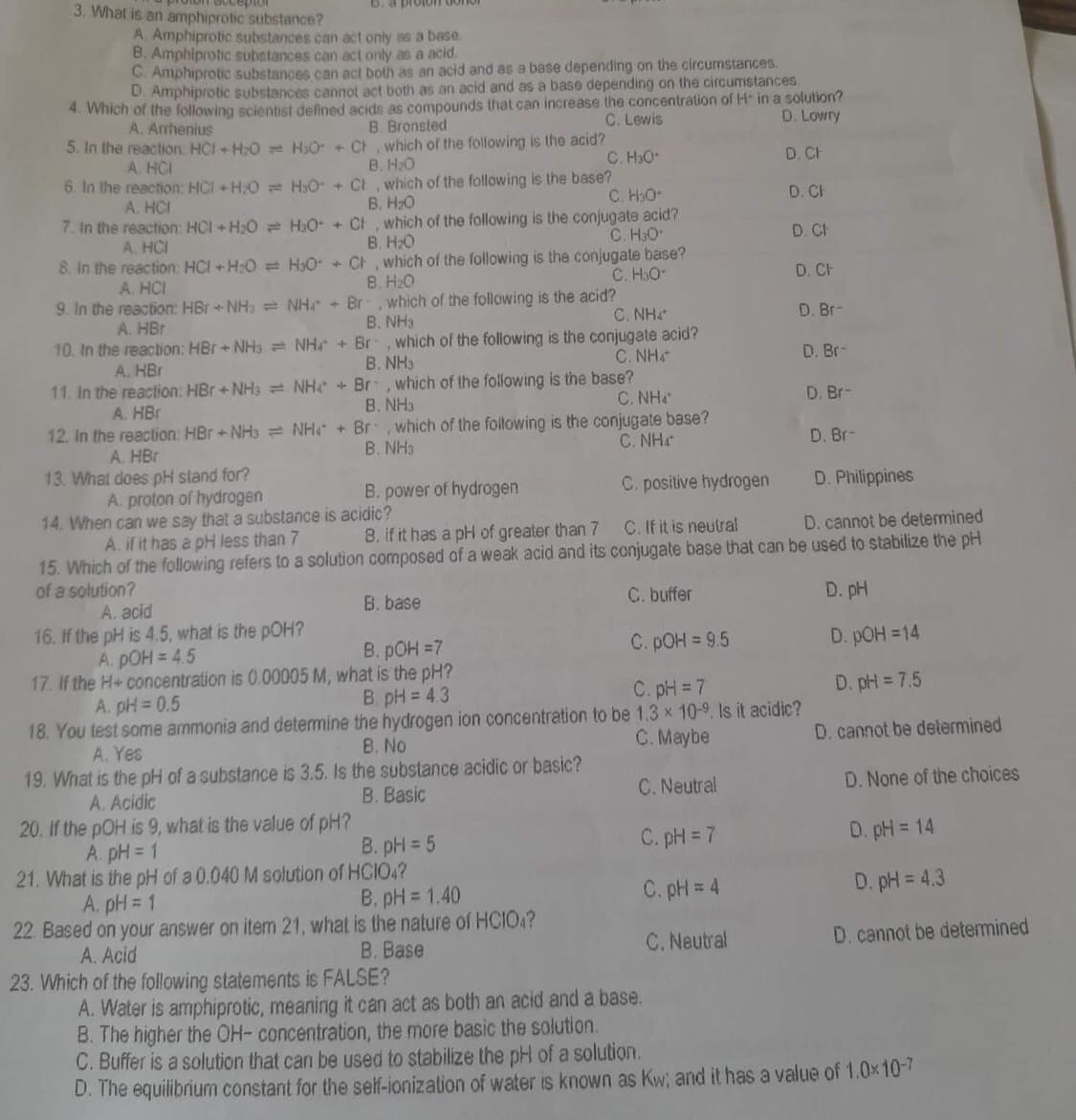C Amphiprotic substances can act both as an acid and as a base depending on the circumstances. D. Amphiprotic substances cannot act both as an acid and as a base depending on the circumstances. 4. Which of the following scientist defined acids as compounds that can increase the concentration of H in a solution? A. Arrhenius B. Bronsted C. Lewis D. Lowry 5. In the reaction: HCI+H₂0 H₂O + Ct, which of the following is the acid? A. HCI B. H₂O C. H30 D. CH 6. In the reaction: HCI+H₂O A. HCI HO + Ch, which of the following is the base? B. H₂O C. H₂O D. CH 7. In the reaction: HCI+H₂O A. HCI H₂O + Ct, which of the following is the conjugate acid? C. H3O* B. H₂O D. CH 8. In the reaction: HCI+H₂O = H₂O + Ch, which of the following is the conjugate base? A. HCI B. H₂O C. H₂O D. CH 9. In the reaction: HBr + NH3 = NH + Br which of the following is the acid? A. HBr B. NH3 D. Br- 10. In the reaction: HBr + NH3 A. HBr C. NHƯ NH+ Br, which of the following is the conjugate acid? B. NH3 C. NHƯ Br, which of the following is the base? B. NH3 C. NHỚ D. Br- NH+ 11. In the reaction: HBr + NH3 = A. HBr D. Br- 12. In the reaction: HBr + NH3 = NH+ Br, which of the following is the conjugate base? B. NH3 A. HBr C. NHƯ D. Br- 13. What does pH stand for? A. proton of hydrogen B. power of hydrogen C. positive hydrogen D. Philippines 14. When can we say that a substance is acidic? C. If it is neutral B. if it has a pH of greater than 7 A. if it has a pH less than 7 D. cannot be determined 15. Which of the following refers to a solution composed of a weak acid and its conjugate base that can be used to stabilize the pH of a solution? A. acid B. base C. buffer D. pH 16. If the pH is 4.5, what is the pOH? A. pOH = 4.5 B. pOH =7 C. pOH = 9.5 D. pOH =14 17. If the H+ concentration is 0.00005 M, what is the pH? A. ph=0,5 B. pH = 4.3 C. pH=7 D. pH = 7.5 18. You test some ammonia and determine the hydrogen ion concentration to be 1.3 x 10-9. Is it acidic? A. Yes B. No C. Maybe D. cannot be determined 19. What is the pH of a substance is 3.5. Is the substance acidic or basic? A. Acidic B. Basic C. Neutral D. None of the choices 20. If the pOH is 9, what is the value of pH? A. pH=1 B. pH = 5 C. pH=7 D. pH = 14 1. What is the pH of a 0.040 M solution of HCIO4? A. pH=1 B. pH = 1.40 C. pH=4 D. pH = 4.3 2. Based on your answer on item 21, what is the nature of HC104? A. Acid B. Base C. Neutral D. cannot be determined 3. Which of the following statements is FALSE? A. Water is amphiprotic, meaning it can act as both an acid and a base. B. The higher the OH- concentration, the more basic the solution. C. Buffer is a solution that can be used to stabilize the pH of a solution. D. The equilibrium constant for the self-ionization of water is known as Kw; and it has a value of 1.0x10-7
Ionic Equilibrium
Chemical equilibrium and ionic equilibrium are two major concepts in chemistry. Ionic equilibrium deals with the equilibrium involved in an ionization process while chemical equilibrium deals with the equilibrium during a chemical change. Ionic equilibrium is established between the ions and unionized species in a system. Understanding the concept of ionic equilibrium is very important to answer the questions related to certain chemical reactions in chemistry.
Arrhenius Acid
Arrhenius acid act as a good electrolyte as it dissociates to its respective ions in the aqueous solutions. Keeping it similar to the general acid properties, Arrhenius acid also neutralizes bases and turns litmus paper into red.
Bronsted Lowry Base In Inorganic Chemistry
Bronsted-Lowry base in inorganic chemistry is any chemical substance that can accept a proton from the other chemical substance it is reacting with.

Step by step
Solved in 2 steps









